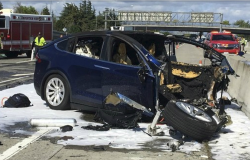
— A Tesla Model X wrongful death lawsuit has been filed by the family of Walter Huang who was killed in a March 2018 crash in Mountain View, California. The lawsuit alleges Huang died because he believed Tesla's advertising about the safety of the Autopilot system and other features.
The 38-year-old driver was killed when his Model X slammed into a crash attenuator located at the end of a concrete median barrier. According to the government, a "crash attenuator is a device intended to reduce the damage to structures, vehicles, and motorists from a motor vehicle collision by absorbing the colliding vehicle’s kinetic energy."
Data recovered from the Tesla showed traffic-aware cruise control and autosteer lane-keeping assistance were activated, both that are features included in the Autopilot system. The vehicle was traveling nearly 71 mph when it slammed into the crash attenuator that had been previously damaged.
According to the National Transportation Safety Board, the Autopilot system was engaged four different times during the 32-minute trip, including for the last 18 minutes 55 seconds prior to the crash.
Walter Huang received two visual alerts and one auditory alert to place his hands on the steering wheel more than 15 minutes prior to the crash. During the 60 seconds prior to the crash, his hands were detected on the steering wheel three times for a total of 34 seconds. However, the vehicle did not detect the driver’s hands on the steering wheel the last six seconds prior to the crash.
Federal safety investigators found the Model X had been following a lead vehicle traveling 65 mph just eight seconds before the crash, but at four seconds the Tesla had moved to the left and wasn't following a lead vehicle.
There was no evidence of any evasive steering movements and no evidence the brakes were activated as the Model X jumped to 70.8 mph from 62 mph just three seconds before the crash.
Although the data shows the driver's hands weren't on the steering wheel and he took no action to avoid the barrier, the lawsuit alleges Tesla caused the crash and resulting death of Huang.
According to the plaintiffs, there is no way a Tesla vehicle with Autopilot engaged should leave a marked travel lane and accelerate without the driver touching anything.
The lawsuit alleges the automatic emergency braking system should have avoided or at least reduced the severity of the crash and the system should not have allowed the Model X to accelerate into a fixed object.
Tesla says the Model X owner's manual is clear that Autopilot may fail to recognize lane markers or objects in the road and a driver should be fully aware of what the SUV is doing.
In addition to Tesla, the plaintiffs sued the state of California for not replacing or repairing the crash attenuator that had been damaged in a separate crash about 10 days before.
The Tesla Autopilot wrongful death lawsuit was filed in the Santa Clara County California Superior Court - Huang v. Tesla Inc., et al.
The plaintiffs are represented by Minami Tamaki LLP, and Walkup, Melodia, Kelly & Schoenberger.




